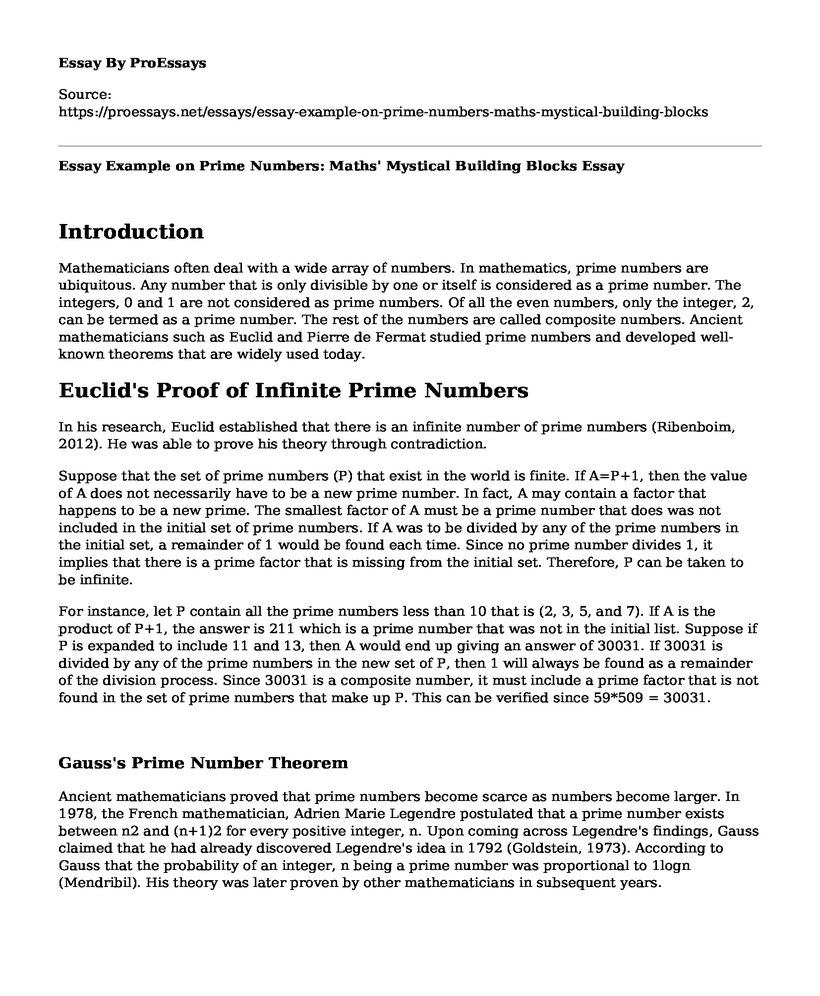Introduction
Mathematicians often deal with a wide array of numbers. In mathematics, prime numbers are ubiquitous. Any number that is only divisible by one or itself is considered as a prime number. The integers, 0 and 1 are not considered as prime numbers. Of all the even numbers, only the integer, 2, can be termed as a prime number. The rest of the numbers are called composite numbers. Ancient mathematicians such as Euclid and Pierre de Fermat studied prime numbers and developed well-known theorems that are widely used today.
Euclid's Proof of Infinite Prime Numbers
In his research, Euclid established that there is an infinite number of prime numbers (Ribenboim, 2012). He was able to prove his theory through contradiction.
Suppose that the set of prime numbers (P) that exist in the world is finite. If A=P+1, then the value of A does not necessarily have to be a new prime number. In fact, A may contain a factor that happens to be a new prime. The smallest factor of A must be a prime number that does was not included in the initial set of prime numbers. If A was to be divided by any of the prime numbers in the initial set, a remainder of 1 would be found each time. Since no prime number divides 1, it implies that there is a prime factor that is missing from the initial set. Therefore, P can be taken to be infinite.
For instance, let P contain all the prime numbers less than 10 that is (2, 3, 5, and 7). If A is the product of P+1, the answer is 211 which is a prime number that was not in the initial list. Suppose if P is expanded to include 11 and 13, then A would end up giving an answer of 30031. If 30031 is divided by any of the prime numbers in the new set of P, then 1 will always be found as a remainder of the division process. Since 30031 is a composite number, it must include a prime factor that is not found in the set of prime numbers that make up P. This can be verified since 59*509 = 30031.
Gauss's Prime Number Theorem
Ancient mathematicians proved that prime numbers become scarce as numbers become larger. In 1978, the French mathematician, Adrien Marie Legendre postulated that a prime number exists between n2 and (n+1)2 for every positive integer, n. Upon coming across Legendre's findings, Gauss claimed that he had already discovered Legendre's idea in 1792 (Goldstein, 1973). According to Gauss that the probability of an integer, n being a prime number was proportional to 1logn (Mendribil). His theory was later proven by other mathematicians in subsequent years.
Fermat's Last Theorem
In 1637, Pierre de Fermat stated that the sum of two cubes of any natural integers cannot be equal to the cube of any natural integer (Britannica, 2017). For instance 52+42=41. 41 is not a cube of any natural number. His theory was later solved by an English professor named Sir Andrew Wiles.
Conclusion
It is evident that the mathematic principles on prime numbers that are widely used today were formulated and proved by mathematicians after years of extensive research.
References
Britannica, Encyclopaedia. (2017, March 9th). Fermat's Last Theorem. Retrieved from https://www.britannica.com/science/Fermats-last-theorem
Goldstein, L. J. (1973). A history of the prime number theorem. The American Mathematical Monthly, 80(6), 599-615. Retrieved from https://www.tandfonline.com/doi/abs/10.1080/00029890.1973.11993338?journalCode=uamm20
Mendribil, J. A Discussion on Legendre's Conjecture. Retrieved from https://pdfs.semanticscholar.org/2ad3/4186a73368b213a872a763120d7b353c205a.pdf
Ribenboim, P. (2012). The new book of prime number records. Springer Science & Business Media. Retrieved from https://books.google.co.ke/books?hl=en&lr=&id=2VTSBwAAQBAJ&oi=fnd&pg=PR9&dq=
Ribenboim, P (2012).The+new+book+of+prime+number+records.+Springer+Science+%26+Business+Media.&ots=yiKkAO0FMH&sig=DgvjrOPLv-ENF_mtWWhmd-c9_Jw&redir_esc=y#v=onepage&q=
Cite this page
Essay Example on Prime Numbers: Maths' Mystical Building Blocks. (2023, Jan 16). Retrieved from https://proessays.net/essays/essay-example-on-prime-numbers-maths-mystical-building-blocks
If you are the original author of this essay and no longer wish to have it published on the ProEssays website, please click below to request its removal:
- Expansion Beginning 1500 of Asian Empires
- A Bulky Glycocalyx Fosters Metastasis Formation by Promoting G1 Cell Cycle Progression
- Essay Sample on Approaches to Improve Math Scores
- Research Paper on Isotopic Approaches in Global Change Ecology
- Essay on Croda Int'l Plc: Global Leader in Chemical Prod. for Many Industries
- Free Essay Sample on Exploring and Terraforming Mars: A Feasible Proposal for Human Colonization
- Thomas Graham: Pioneering Chemistry through Graham's Law of Diffusion and Scientific Contributions - Free Paper







